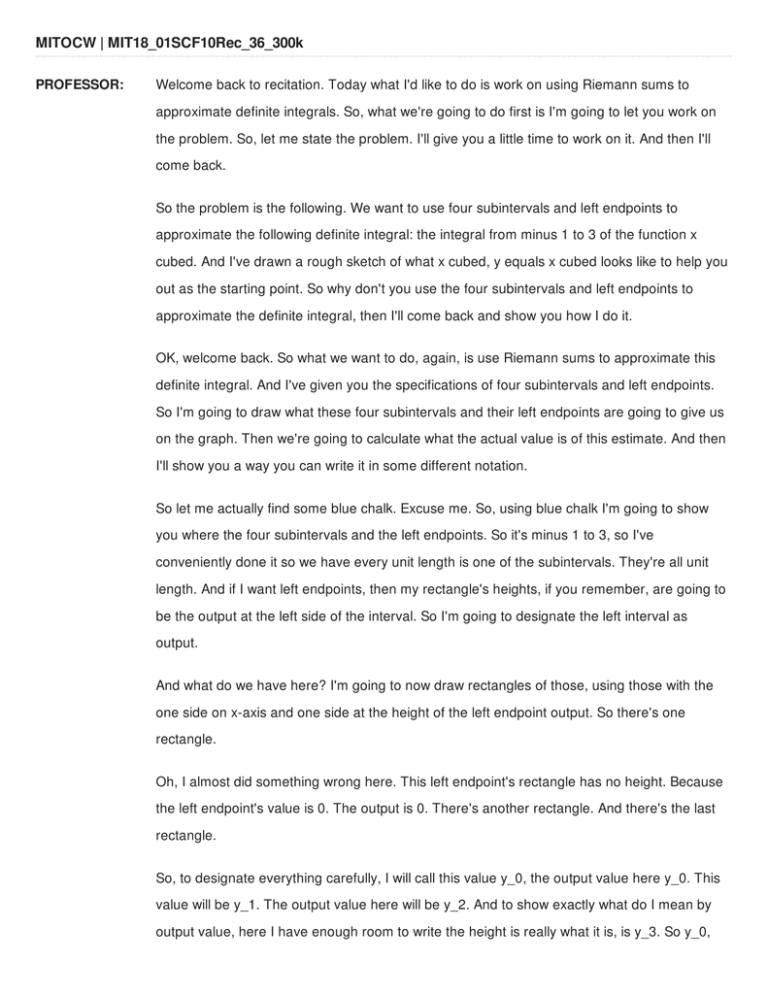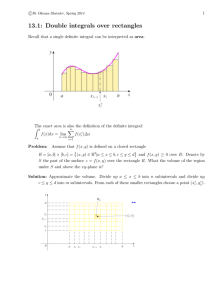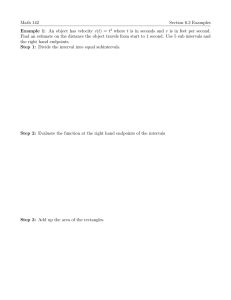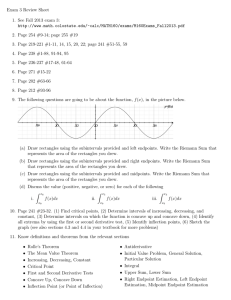MITOCW | MIT18_01SCF10Rec_36_300k
advertisement

MITOCW | MIT18_01SCF10Rec_36_300k PROFESSOR: Welcome back to recitation. Today what I'd like to do is work on using Riemann sums to approximate definite integrals. So, what we're going to do first is I'm going to let you work on the problem. So, let me state the problem. I'll give you a little time to work on it. And then I'll come back. So the problem is the following. We want to use four subintervals and left endpoints to approximate the following definite integral: the integral from minus 1 to 3 of the function x cubed. And I've drawn a rough sketch of what x cubed, y equals x cubed looks like to help you out as the starting point. So why don't you use the four subintervals and left endpoints to approximate the definite integral, then I'll come back and show you how I do it. OK, welcome back. So what we want to do, again, is use Riemann sums to approximate this definite integral. And I've given you the specifications of four subintervals and left endpoints. So I'm going to draw what these four subintervals and their left endpoints are going to give us on the graph. Then we're going to calculate what the actual value is of this estimate. And then I'll show you a way you can write it in some different notation. So let me actually find some blue chalk. Excuse me. So, using blue chalk I'm going to show you where the four subintervals and the left endpoints. So it's minus 1 to 3, so I've conveniently done it so we have every unit length is one of the subintervals. They're all unit length. And if I want left endpoints, then my rectangle's heights, if you remember, are going to be the output at the left side of the interval. So I'm going to designate the left interval as output. And what do we have here? I'm going to now draw rectangles of those, using those with the one side on x-axis and one side at the height of the left endpoint output. So there's one rectangle. Oh, I almost did something wrong here. This left endpoint's rectangle has no height. Because the left endpoint's value is 0. The output is 0. There's another rectangle. And there's the last rectangle. So, to designate everything carefully, I will call this value y_0, the output value here y_0. This value will be y_1. The output value here will be y_2. And to show exactly what do I mean by output value, here I have enough room to write the height is really what it is, is y_3. So y_0, y_1, y_2 and y_3 designate the heights of these four rectangles. And the length of each rectangle, if you remember, is really what we designate as delta x. So this right here is delta x. And in this case delta x is each time equal to 1. So, remember, formally, what we want to do is, if we want to find this definite integral, we want to find the area under the curve between the x-axis and the function x cubed. And remember this is signed area. So anything below the x-axis has a negative sign associated to it. Anything above the x-axis has a positive sign associated to it. So, when I'm trying to determine this, when I'm trying to do an estimate, I'm finding the areas of these rectangles. So my first approximation that I've given here, is we want the four subintervals and the left endpoints. What we really need is this delta x, which is the base, times the height, which is y_0, 1, 2 and 3, of each of these rectangles. So, to write it carefully-- well I guess this won't be the most careful way we write it-- but I have the base, which is delta x in each case, times y_0 plus y_1 plus y_2 plus y_3. And the only thing I have to be careful of is that the area of the rectangle here will be negative. But how do I pick that up? I pick that up because this y_0 value, as an actual output, is negative. So that actually will be picked up automatically by the value of the output on the function. So let's evaluate these things. y_0 should be the value of the function at x equal negative 1. When x is negative 1-- the function, remember, is x cubed, so I get negative 1 cubed, which is just negative 1. So delta x is 1. y_0 is negative 1. y_1 is the value the function at x equals 0, because my left endpoints are minus 1, 0, 1 and 2. So the second one is 0 is the input. At x equals 0 I get 0 as an output. The y_2 is going to be this third left endpoint. That's at x equal 1. 1 cubed is 1. So I get a 1 there. And then, the third left endpoint, I had minus 1, 0, 1, 2. So the third left endpoint is 2. 2 cubed is 8. And so y_3 is 8. Hopefully the subscripts here didn't confuse you because I actually was very close to having the subscripts represent the x-value. But that's not in fact what the subscripts are doing. The subscripts are just representing what interval we are looking at. So the four intervals are designated by 0, 1, 2 and 3. So I get, when I put this all together I get 1 times-- well, minus 1 plus 1 is 0-- 1 times 8. So I get 8. And if I wanted to look at the picture, how is that represented? Well this rectangle has base 1 and height 8. So that has area 8. This rectangle is actually a square. It has base 1, height 1. And this one is also a square. It has base 1, height 1. But because it's below, it has a minus sign associated to it, when I think about it in terms of area. So I get minus 1 plus 1 plus 8. And that's where the 8 comes from. Now if I wanted to write this in terms of a Riemann sum, you see them sometimes written in this way. You can think about it in a formal sum in this way. You've probably seen this in the lecture videos more like this. The sum from i equals 0 to 3 of f of x sub i delta x. And now, in this case, we could even be more deliberate if we wanted to. And we could let x sub i be designated by some value. We could say, starting at negative 1 and adding some number to it each time based on the interval. But this is sort of the easiest way to write out what we're interested in. And then the x sub i's are going to be designated separately. We can write x sub 0 is equal to minus 1, x sub 1 is equal to 0, x sub 2 is equal to-- sorry, not minus 1-- is equal to plus 1. And x sub 3 is equal to 2. So in that case, that's what we would get there. And we could write it in that way and then get the same values. So I think I will stop there.

![0 ) ( ]](http://s2.studylib.net/store/data/010595988_1-ff7c39c326404fcb7dda56030ddecd8b-300x300.png)



